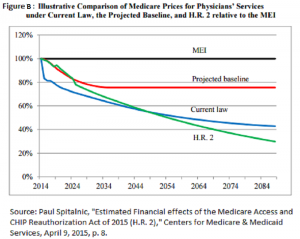Chief Actuary Blows Away Make-Believe Medicare “Doc Fix”
A similar version of this Health Alert appeared at Forbes.
On March 25, the U.S. House of Representatives voted for a fiscally irresponsible so–called Medicare “doc fix” that will add $141 billion to the deficit over the next ten years, according to the Congressional Budget Office (CBO). The U.S. Senate will likely vote on the bill later today, and the same lobbyists who dragged Obamacare into the end zone in 2010 are hoping for another win. This one will be even better, because it will be bipartisan.
Nobody denies the way Medicare pays doctors today is flawed. Every year, Congress has to increase the scheduled amount of money because if it did not, fees would drop by about one fifth. Many doctors would stop seeing Medicare beneficiaries.
There are two major differences between this so-called “fix” and previous ones. The first one is real: Previous increases have been offset by cuts to other government spending, and this one is not. The second one is fiction: That this doc fix is a permanent solution to the fee problem.
That fiction was debunked last week in a report published by Medicare’s Chief Actuary.
First, the Chief Actuary has a significantly higher estimate of the gross cost of increasing physicians’ fees over the next 10 years than the CBO did. As shown in Table 1, the differences are trivial for the first few years, but they grow with time. Over the entire 11-year period, the Chief Actuary estimates the increase in payments will be $205 billion, $29 billion more than CBO’s estimate.
And it gets worse: Even this “fix” is no fix at all, but as unrealistic and broken as the current fee schedule. Medicare’s Trustees do not believe the current fee schedule is credible, so they estimate a “projected baseline” which they calculate by taking an average of the last 10 years of actual increases Congress adds on to the fee schedule, and using that to project a realistic estimate of future Medicare physician spending.
Figure A compares this projection to spending under both current law and H.R. 2. Current law is the “broken” fee schedule over which lobbyists have been gnashing their teeth for years. H.R. 2 is the bill that the Senate is expected to vote on today, cheered by the same lobbyists as a final fix to the payment problem.
Clearly, the differences between current law and H.R. 2 are trivial after a few years. The Chief Actuary points out that H.R. 2 actually results in lower payments than current law by 2048. However, the two lines pretty much come together by 2025. Well, a decade’s grace is pretty good for government work, right?
Not at all. In no scenario do physicians maintain a real (inflation adjusted) level of Medicare fees. Figure B compares fees to the Medicare Economic Index (MEI), a measurement of inflation of costs to operate a physician’s practice. Under current law, real fees would drop by one fifth very quickly. However, recall that current law never takes effect. Congress always increases fees, at least once a year. Under H.R. 2, the slope of the decline is just a little gentler, but the result is the same.
Plus, physicians bear more risk under H.R. 2 than current law, because the fee adjustments in H.R. 2 are not linked to inflation. If inflation jumps higher than expected, doctors will fall further behind. In such a case, it would be better to revisit the fee schedule annually.
There is not really any good news in the Chief Actuary’s report. Yes, because H.R. 2 cuts some payments to hospitals, he estimates a $387 billion reduction in Medicare’s hospital “trust fund” liabilities. However, this is not very exciting because it amounts to less than two percent of that $20,385 billion liability, and only delays bankruptcy by one year from 2030 to 2031. Further, it is less than the $500 billion that the Committee for a Responsible Federal Budget estimates H.R. 2 will add to the national debt.
This so-called “doc fix” promises little reward to either physicians or taxpayers, and imposes new risks on both. This doc fix needs to be fixed, as I have proposed in a new Issue Brief.





When they keep referring to a precipitous 21% drop in medicare payments to physicians with the “kick the can down the road” measures to get around the SGR, no one seems to get the fact that the fees for many popular services (total hip and knee replacement) have fallen in value approximatly 75% over the past 25 years. This is between the reimbursement being lowered many times, and the inflation involved in this time period. The token 0.5 and 1% increases that have occurred were offset last year totally by 5 and 10% decreases in reimbursement.
With mounting practice costs, and lowered reimbursement, physician work schedules have soared, causing burn out and dissatifaction. There are already physicians who are dropping out of the Medicare program. With the upcoming glut of baby boomer Medicare patients coming, the prophesied doctor shortage will become reality.
Nah, they’ll just hire physician extenders to do the work.
Thank you, and I agree. The gap between Medicare fees and cost of operating a practice has shrunk dramatically. This “doc fix” does not fix that at all.